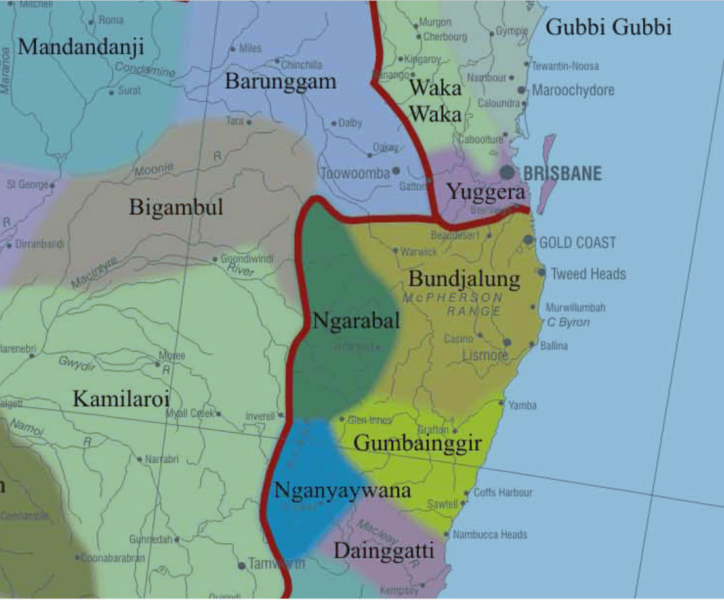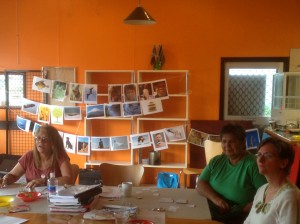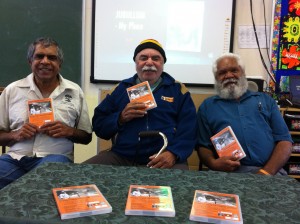Language Today
The Bundjalung language is experiencing a revival and is now being taught and spoken across various parts of Bundjalung Country.

Rick Cook, a long-time language teacher, has dedicated decades to this work. You can watch his interview “Sharing Bundjalung Mother Tongue” here: https://www.youtube.com/watch?v=MAz5wSeFVPM
Bundjalung is also one of the languages supported by the Language Nests initiative, established by the Department of Aboriginal Affairs. For more information, you can contact language teacher Glen Rhodes at: rhodes@det.nsw.edu.au
In Ballina, the Bunjum Aboriginal Corporation runs the Culture Matters Project, supporting local Aboriginal artists in developing their visual arts, including painting, sculpture, textiles, and more. For updates on their language teaching initiatives, visit: http://www.bunjum.com.au/our-programs-services/culture-matters/
The Yugambeh Museum, Language and Heritage Research Centre is also dedicated to preserving and promoting the traditional knowledge of the region, particularly the Yugambeh language. Learn more at: https://www.yugambeh.com/
Recording Elders
Muurrbay has collaborated with several Bundjalung speakers and community organisations to support language revitalisation. Among these efforts is the recording of introductory Bundjalung–Wahlubal language lessons by Poppy Harry Walker. These recordings are scheduled for online release in 2022 to improve public access.
Although the respected Elder Uncle Charles Moran has since passed away, Muurrbay was honoured to have recorded some of his valuable language knowledge.
The Bundjalung–Yugambeh Online Dictionary is the result of many years of research conducted with Elders from regions spanning the Clarence River in NSW to Beenleigh and Beaudesert in QLD. Compiled by linguist Margaret Sharpe and developed into a digital resource by IT specialist Cat Kutay, the dictionary can be accessed at: https://bundjalung.dalang.com.au/language/dictionary
An electronic version of the Bundjalung–Yugambeh Dictionary is freely available online
here.
Language and Dialect Names
When Europeans first made contact with the Bundjalung people in the mid-1800s, there were up to 20 distinct dialects of the Bundjalung language. The term “Bundjalung” has been broadly used to refer both to the overall language encompassing these dialects and, at times, to specific individual dialects. However, each dialect has its own unique name.
Some of the known dialects include: Wahlubal (also known as Western Bandjalang), Yugambeh, Birrihn, the Barryugil dialect, Bandjalang, Wudjebal, Wiyabal, Wuhyabal, Minyangbal, Gidhabal, Galibal, and Ngarrahngbal.
Many of these names reflect features of the dialect itself. For example, Gidhabal means “those who say gidha for ‘alright’,” while Wiyabal means “those who say wiya for ‘you’.” The name Bandjalung is believed to have originally referred to the dialect spoken around Bangawalbin Creek.
Since the late 1800s, numerous individuals, including researchers, have been documenting the Bundjalung language. A substantial archive of audio recordings of Bundjalung speakers, along with researchers’ field notes, is held at the Australian Institute of Aboriginal and Torres Strait Islander Studies (AIATSIS) in Canberra.
Four dialects in particular have been described in detail:
- Yugambeh: Cunningham’s 1969 grammar
- Gidabal: the Geytenbeek’s 1971 grammar and word-list;
- Wahlubal or Western Bundjalung: Crowley’s 1978 grammar and wordlist is the most detailed available;
- Casino dialect: Smythe’s 1940s description first appeared in Crowley 1978;
There are brief sketch grammars on several Bundjalung dialects, including:
- Minjangbal dialect of Byron Bay, Livingstone (1892),
- Biirin dialect of Rappville and the Baryulgil dialect, Crowley (n.d)
- Bundjalung dialect of Bungawalbin Creek, Holmer (1971)
- over 17 word-lists from various areas, Hargrave (Science of Man:1903)
- Sharpe’s description of the ‘Yugambeh-Bundjalung dialect chain’.
Language Features
- A variety of spelling systems are being used for different dialects. Work that Muurrbay has been involved in uses the following
- Bundjalung has four vowels, written: i, a, u and e, they can also be pronounced as a longer vowel. There are ten consonants: b, d, dj, g, m, n, ng, ny, l, r, w and y.
- Nouns take many different suffixes (tag endings) to mark such roles as subject, object, instrument, location, movement towards, possession and to make feminine from masculine nouns. Nouns can also show singular and plural in three classes: masculine, feminine, and neuter or tree nouns.
- Verbs have four tenses: future, present, and two pasts; various suffixes also show that someone ‘keeps on’ doing something, or that people are doing something ‘to each other’ .
- Word order is fairly free, although there is a tendency toward Subject – Object – Verb word order.
Books etc
Gurgun Mibinyah: Yugambeh, Ngarahngwal, Ngahnduwal: A dictionary and grammar of Mibiny language varieties from the Logan to the Tweed rivers 2020, Margaret Sharpe. Gurgun Mibinyah means belonging to Mibiny speakers. This is a dictionary-grammar of the northern varieties of the Yugambeh-Bundjalung language group.
All Yugambeh-Bundjalung Dictionary and Grammar can be ordered from the author at: https://margaretcsharpe.wordpress.com/all-yugambeh-bundjalung-dictionary-and-grammar/
An electronic version of the Bundjalung-Yugambeh Dictionary is available online here.
Written Examples of the Language
These sentences are from Wahlubal/Western Bandjalang ( Crowley:1978).
Ngay waymalehla nganyahya nguyaya.
I am speaking my own language.
Nyarram mala behn gudjahrra.
The frilled-neck lizard fell into a hole.
Wanah yirrali-ngahyumah.
Don’t (speak in) English.
Mala baygal djehrr.
That man is big.
Djununu wudja yang giwani.
Where have you come from?
Maliyu dandaygambu yarbini.
That man sang (a song).
Mala bin-gihng birrah waybarra mala waganyngula.
Throw that turtle onto the fire, and that catfish too!
Yuh ngali yanah buyan gala djahnanah.
Let’s go later when the wind stops.

